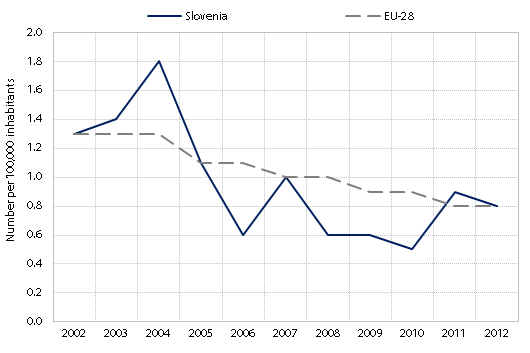SOCIAL WELL-BEING - Personal security
The indicator Mortality due to assault measures the number of deaths due to assault per 100,000 inhabitants and is shown with the age-standardised death rate. This is one of the important indicators of the extent of the worst violence and thus of personal security, which belongs among the basic factors of the quality of life. Growth of the indicator has a negative impact on well-being.
Figure: Standardised death rate due to assault per 100,000 inhabitants, Slovenia and the EU, 2002−2012

Vir podatkov: Eurostat.
In 2011, standardised death rate due to assault (measured per 100,000 inhabitants) in Slovenia was 0.9; a year earlier it was 0.5. So, for the first time after 2004 it was slightly above the EU average (0.8). In 2012, it declined to the EU average of 0.8.
Results of supplementary indicators show:
Also less favourable was the situation regarding security against burglary or assault. In 2014 (10.5%, provisional data) the share of people who had been victims of a burglary or assaults in the last five years was slightly higher than in 2012; however, it was still lower than before the crisis. Compared to the EU (2012: 18.4%) Slovenia is still a rather safe country.
The share of persons who feel safe when walking alone in a local area after dark remains high, but in 2014 (provisional data) it was lower (92.9%) than in 2012 (94.2%). The comparable share in the EU is only 81.2%.
In Slovenia mortality due to transport accidents was higher in 2011 than in 2010; 8.5 deaths per 100,000 inhabitants is less than in the 1996−2009 period, but Slovenia is still above the EU average (6.9). In 2012, the rate declined to 8.0, but the gap with the EU widened as in the EU overall the rate was 6.3.
People’s trust in the police has been rising for the past few years. In 2014 (provisional data) in Slovenia the average assessment on the scale from 0 to 10 was 5.5 and thus the highest in the past 12 years. However, trust in Slovenia is still lower than in the EU overall (2012: 6.4).
